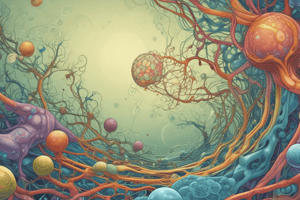Podcast
Questions and Answers
What is the function of the cell membrane in a cell?
What is the function of the cell membrane in a cell?
regulates what enters and leaves the cell
What is the primary function of the mitochondria in a cell?
What is the primary function of the mitochondria in a cell?
generate ATP
What type of cell division produces four non-identical daughter cells?
What type of cell division produces four non-identical daughter cells?
meiosis
What is the term for the movement of molecules from high to low concentration?
What is the term for the movement of molecules from high to low concentration?
What is the function of the ribosomes in a cell?
What is the function of the ribosomes in a cell?
What is the term for the process by which cells respond to changes in their environment?
What is the term for the process by which cells respond to changes in their environment?
What is the outcome of meiosis in terms of the number and genetic makeup of the resulting cells?
What is the outcome of meiosis in terms of the number and genetic makeup of the resulting cells?
What is the role of gametophytes in the life cycle of plants?
What is the role of gametophytes in the life cycle of plants?
What is the significance of pollination in terms of genetic diversity?
What is the significance of pollination in terms of genetic diversity?
What is the result of fertilization in plants?
What is the result of fertilization in plants?
What are the three main components of a seed?
What are the three main components of a seed?
What is the significance of crossing over during meiosis I?
What is the significance of crossing over during meiosis I?
Flashcards are hidden until you start studying
Study Notes
Cell Biology
Cell Structure
- Cell membrane: semi-permeable, regulates what enters and leaves the cell
- Cytoplasm: gel-like substance inside the cell membrane, site of metabolic reactions
- Nucleus: control center of the cell, contains DNA
- Mitochondria: energy-producing organelles, generate ATP
- Endoplasmic reticulum (ER): synthesizes proteins and lipids
- Ribosomes: site of protein synthesis
- Lysosomes: contain digestive enzymes, break down waste and foreign substances
- Golgi apparatus: processes and packages proteins and lipids for transport
- Cytoskeleton: provides structural support, shape, and movement
Cell Functions
- Metabolism: energy conversion, biosynthesis, and degradation of molecules
- Transportation: movement of molecules in and out of the cell
- Signaling: communication between cells, through hormones, neurotransmitters, and signaling pathways
- Reproduction: cell division, growth, and differentiation
- Response to stimuli: cells respond to changes in their environment
Cell Division
- Mitosis: somatic cell division, produces two identical daughter cells
- Meiosis: reproductive cell division, produces four non-identical daughter cells
- Interphase: cell growth, replication of DNA, and preparation for cell division
- Cytokinesis: separation of daughter cells, follows mitosis or meiosis
Cellular Transport
- Passive transport: movement of molecules from high to low concentration
- Diffusion: random movement of molecules
- Osmosis: movement of water molecules
- Active transport: movement of molecules from low to high concentration
- Carrier proteins: transport molecules against concentration gradient
- Pumps: transport molecules against concentration gradient, using energy
Studying That Suits You
Use AI to generate personalized quizzes and flashcards to suit your learning preferences.




